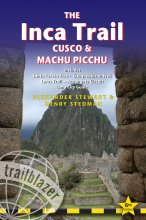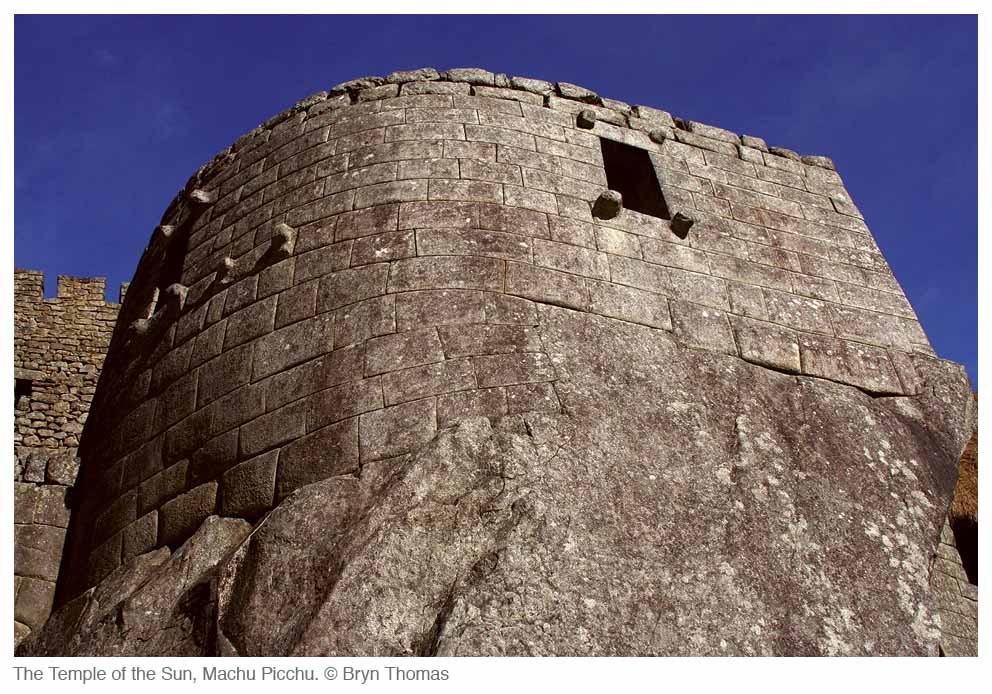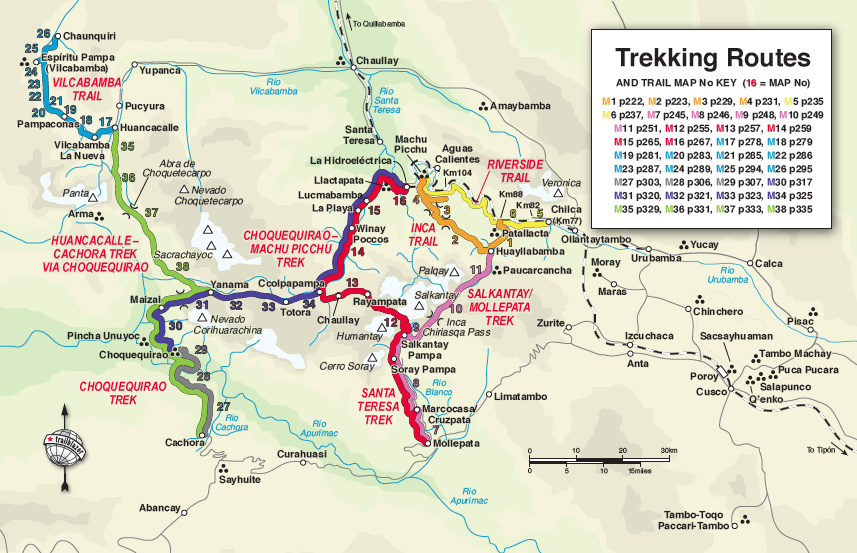I've said it before and I'll say it again, Trailblazer guides take some beating.
— Adventure Travel

The Inca Trail, Cusco & Machu Picchu
Excerpt:
Route options
Contents | Introduction | With a tour group or on your own? | Route options | Sample route guide | Food & drink

Route options
The treks described in this book offer a selection of routes to Machu Picchu which take various lengths of time and cater for people of varying abilities and interest levels.
The legendary Inca Trail has become a ‘must do’ for many travellers. However, the popularity of the trek has meant that the trail and the ruins along it have had to deal with an increasing number of visitors. To counter the detrimental effects of this influx, the Peruvian government has imposed a strict limit on the number of people able to start the trek at any one time. The result has been that many people have fallen foul of the regulations and been unable to tackle the trek.
The good news, though, is that there are several alternative treks in the Cusco region, many of them on original Inca trails to less well-known but similarly stunning sites such as Choquequirao and Vilcabamba; routes and ruins that may be more appealing in some respects as you don’t have to share them with 500 other people. There are also two much longer, more difficult expeditions that actually link several of the key Inca sites and provide you with a wonderful, broad experience of the region, its history and its archaeological remains.

THE CLASSIC INCA TRAIL [3-4 days, see pp218-34]
This is the trek that most people think of when picturing Peru: it has become synonymous with the country. Beginning at Km88 on the railway line to Aguas Calientes, the trek follows an original Inca path uncovered in 1911 by Hiram Bingham and developed in 1944 by Dr Paul Fejos, past the restored ruins at Patallacta, Runcu Racay, Sayacmarca, Phuyu Pata Marca, Intipata and Huinay Huayna to arrive eventually at Machu Picchu.
The 43km (26?-mile) trek is reasonably gruelling; although some of the trek is through exquisite cloud forest and rich subtropical jungle, other stages are through exposed mountain scenery and the path also crosses two steep-sided passes at 4200m/13,750ft.
This trail is subject to the Inca Trail regulations and permits must be secured well in advance of departure. It is closed completely during February.
VARIATIONS ON THE CLASSIC TRAIL
There are two straightforward variations to the classic Inca Trail. The first (see p234) begins at the village of Chilca, which stands at Km77 on the railway line before tracking alongside the Urubamba River to join the original trail from Km88. Dry and dusty, it isn’t all that interesting and not really worth the additional day’s hike unless your tour happens to begin from here.
The other option (see p236) is to begin at Km82, which offers half a day’s more riverside stroll than the Km88 option, but is less monotonous than the Km77 stretch. You also get to visit the ruins at Huillca Raccay, which overlook Patallacta. Trekkers on both these routes are at the mercy of the Inca Trail regulations and must secure a permit well in advance.
SHORTER TRAILS
For those pushed for time or not inclined to mount a 4-day trek to Machu Picchu, there are several options that allow you to get a sense of the approach route to the ruins and then explore the site itself without having to resort to the shuttle bus from Aguas Calientes.
Km104 and the Purification Trail [2 days, see pp239-40]
There are two route options from Km104 on the railway, both of which take two days to complete, although only one of these is actually spent trekking. From the Inca ruins at Chachabamba you can scale a steep hillside on a narrow, exposed path to reach Huinay Huayna and then join the classic Inca Trail for the final approach to Machu Picchu. Alternatively you can head down the river to Choquesuysuy before tackling an arduous three-hour climb to Huinay Huayna along a route nicknamed the ‘Purification Trail’.
Since the Trekker’s Hostel at Huinay Huayna has long since closed there is nowhere to stay. Consequently you must descend through Machu Picchu to stay in Aguas Calientes before returning to explore the site the following morning. Both options are subject to the Inca Trail regulations and trek permits must be reserved well in advance. The route is open during February though, when the main, classic approach to Machu Picchu is shut.
Km88 Riverside Trail [2-3 days, see pp240-1]
From Km88 on the railway line it is possible to follow the Río Urubamba all the way to Km104, from where you are able to ascend to Huinay Huayna via one of two routes. The scenic stroll avoids the tough climbs associated with the classic Inca Trail but it also avoids all the ruins that you would otherwise encounter along the route, making it a far less-attractive option. This trek is also subject to the Inca Trail regulations and should be arranged well in advance.
OTHER TREKS TO MACHU PICCHU
There are two other methods of trekking to Machu Picchu. One is an extended hike that begins with a genuine wilderness experience and a chance to explore the slopes of Mt Salkantay, the sacred mountain of the Incas, before joining the classic Inca Trail for its final three days; the other is an excellent, charming alternative to the classic trail that is currently unregulated and therefore is very popular with those who have fallen foul of the strict Inca Trail regulations.
The Salkantay/Mollepata Trek [6-7 days, see pp241-51]
The name Salkantay derives from the Quecha word ‘Salka’, meaning wild, savage or invincible. It is an apt name for the mountain under which this trek, a dramatic extension of the classic Inca Trail, begins. It includes a stretch of wilderness walking largely free from crowds followed by the rather more popular and crowded classic pilgrimage.
Also known as the Mollepata Trek by some agencies, trek providers and writers, this trail ascends from the village of Mollepata into the mountains where it climbs over a 4950m/16,235ft knife-like pass on the eastern shoulder of Mt Salkantay. From here it descends into the valley of the Urubamba and joins the classic Inca Trail at Huayllabamba before continuing along the traditional route to reach Machu Picchu. Because it joins the Inca Trail, the Salkantay trek is also subject to the Inca Trail regulations and requires you to have a permit, secured well in advance.
The Santa Teresa Trek [3-4 days, see pp252-68]
This route to Machu Picchu, via the ‘backdoor’, has become increasingly popular with those who have failed to book far enough in advance to secure a trek permit for the classic Inca Trail. It is also usually quieter and less heavily used than the traditional route although as more and more people discover it so the amount of traffic on the trail increases. Most agencies offer this trek though they may confusingly refer to it as the Salkantay trek. It’s also the only route where some agents offer the option to stay in lodges (see Mountain Lodges of Peru, p183) rather than simply camp.
The 3- to 4-day trek begins from Mollepata and climbs over a pass (4700m/15,420ft) on the western shoulder of Mt Salkantay before descending into the very attractive, forested Santa Teresa Valley. From here it clambers over a ridge into the Aobamba Valley and then joins the Urubamba Valley, finishing at the foot of Machu Picchu Mountain. Although there are hardly any Inca ruins along the trek, it is a very scenic walk through some of the region’s most picturesque landscapes. The sprawling, partially uncovered yet highly significant site at Llactapata and the fact that the trek finishes on the doorstep of one of the finest archaeological sites in the Americas are some compensation though.
At present, and despite rumblings to the contrary, this route remains free from the Inca Trail regulations and you are able to trek it independently and arrange your own guide and porters. You do need to pay s/129 (approximately US$50) for an INC permit (see box p217) at Soraypampa if your agency has not incorporated the cost into the total fee; this is in addition to the entrance fee for Machu Picchu. Some agencies might try to avoid the checkpoint so as not to pay the fee but this is not to be condoned.
Latest tweets